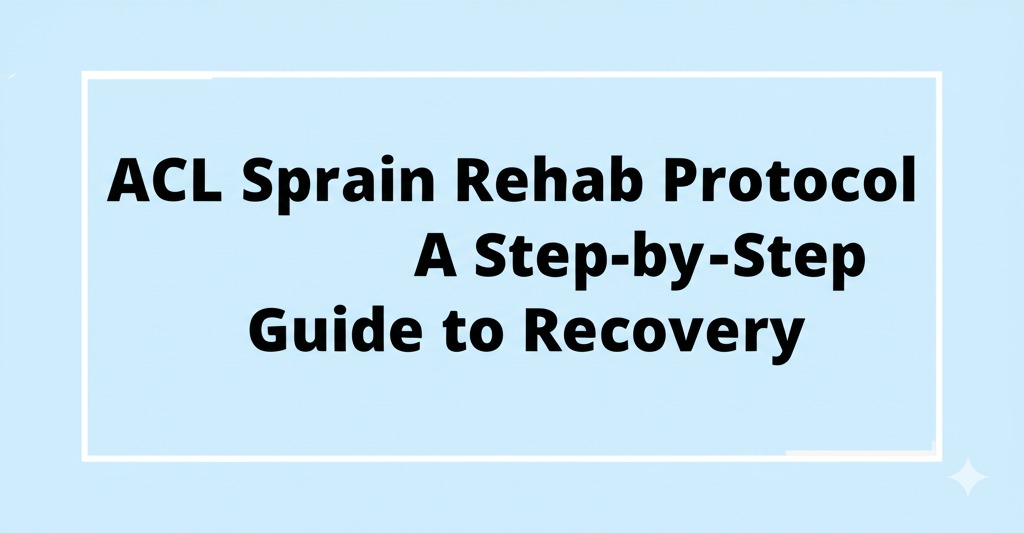An ACL sprain can sideline even the most active individuals, from athletes to weekend warriors. The anterior cruciate ligament (ACL) is a crucial stabilizer in the knee joint, and when it’s injured, getting back to full function requires a thoughtful and structured rehabilitation process. If you’re wondering how to rehab an ACL sprain effectively, this guide outlines everything you need to know—from early recovery to full return to activity.
Whether you’ve suffered a mild sprain or are recovering post-surgery, understanding the ACL rehab protocol can help you heal faster, safer, and smarter.
What Is an ACL Sprain?
Before diving into the rehab steps, it’s important to understand the injury.
An ACL sprain occurs when the ligament is overstretched or partially torn due to:
- Sudden stops or directional changes (common in sports like soccer or basketball)
- Landing awkwardly from a jump
- A direct impact to the knee
ACL sprains are classified into three grades:
- Grade I: Mild overstretching with no significant tear.
- Grade II: Partial tear, leading to some instability.
- Grade III: Complete rupture (often requiring surgical intervention).
Rehabilitation plays a vital role in restoring knee strength, stability, and mobility, especially in non-surgical cases (Grade I-II) or post-surgery recovery (Grade III).
Phase 1: Initial Recovery (First 1–2 Weeks)
Goals:
- Reduce pain and swelling
- Protect the knee
- Begin gentle mobility
What to Do:
- RICE protocol: Rest, Ice, Compression, Elevation
- Use of crutches or a knee brace as recommended
- Light range-of-motion (ROM) exercises such as:
- Heel slides
- Quad sets
- Straight leg raises
Tip: Avoid putting full weight on your injured leg until cleared by your healthcare provider.
Phase 2: Regain Range of Motion and Begin Strengthening (Weeks 2–6)
Goals:
- Restore knee flexibility
- Improve quadriceps and hamstring strength
- Begin light functional training
Recommended Exercises:
- Stationary bike or light pool therapy for cardio
- Wall sits and mini squats
- Resistance band exercises for the hips and thighs
- Step-ups and side leg raises
Key Focus:
- Controlled movements
- Avoiding activities that involve twisting or sudden changes in direction
Phase 3: Advanced Strengthening and Balance Training (Weeks 6–12)
Goals:
- Build muscle strength
- Improve neuromuscular control and balance
- Introduce functional movements
What to Include:
- Leg presses and single-leg squats
- Balance board or Bosu ball exercises
- Core strengthening workouts
- Low-impact agility drills (e.g., side steps, backward walking)
Note: At this stage, you may feel ready for full activity, but it’s crucial to avoid rushing. Controlled progression prevents setbacks.
Phase 4: Return to Sport or Full Activity (3–6 Months)
Goals:
- Full knee strength and stability
- Sport-specific conditioning
- Safe return to play
Activities to Resume:
- Running, cutting, pivoting (as tolerated)
- Plyometric drills (jumping, bounding)
- Sport-specific drills under supervision
Clearance:
Always get medical clearance before returning to high-intensity sports. This may include:
- Functional movement tests
- Strength comparisons between legs
- Psychological readiness assessment
Tips for a Successful ACL Rehab
Here are some key pointers to help you get the best results:
- Stick to your rehab plan: Consistency is everything.
- Communicate with your physical therapist regularly.
- Avoid overdoing it: Too much, too soon can lead to reinjury.
- Fuel your recovery: Eat a balanced diet rich in protein, vitamins, and minerals.
- Stay mentally strong: Setbacks can happen, but a positive mindset speeds recovery.
When to Consider Surgery
If your ACL sprain is classified as Grade III or if instability persists after conservative rehab, surgery may be the best option. Post-operative rehab follows a similar phased approach but may take longer, depending on the procedure and individual progress.
Final Thoughts: Take Charge of Your ACL Rehab
An ACL sprain can feel like a major roadblock—but with a structured rehab protocol, the right support, and a positive attitude, full recovery is absolutely possible. Whether you’re aiming to return to the field or simply walk without pain, following each phase carefully will put you on the path to success.

Kallie Snyder is an author at Stonegate Health Rehab, providing valuable insights, recovery guidance, and rehab resources to help individuals achieve better health and well-being.
